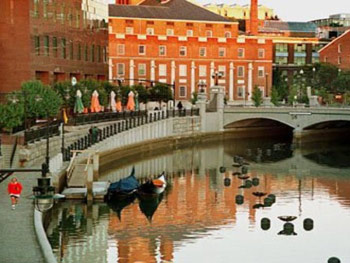Factoring Location Decisions into Watershed Health
An important element of smart growth is the redevelopment and infill of existing urban areas. Many cities have reinvested in older sites that offer connections with existing infrastructure such as road systems and riverfronts. Cleaning up and using these areas often helps to preserve green space and other environmental infrastructure such as wetlands, which might otherwise be developed to accommodate growth. Using brownfields can help save natural lands from sprawl by redeveloping existing urban infrastructure into new urban uses such as shops, commercial buildings and entertainment complexes. For every acre of brownfields redeveloped, it is estimated that an average of 4.5 acres of greenfields are saved (Deason et al. 2001).
As we redevelop most urban parcels every 50 years, we have an opportunity to add best management practices such as raingardens, green roofs, and rainwater storage cisterns.
This photo (left) of Providence, Rhode Island, was taken near the confluence of the Woonasquatucket, Moshassuck and Providence Rivers.
Until the early 19th century, the area was a large salt marsh known locally as "the cove."
By 1860 development in Providence had surrounded the tidal marsh, and the cove had become known as the "cove basin," featuring a promenade adjacent to the city's railroad station. Until the 1870s Providence did not treat its wastewater, and sewage was discharged directly into the three rivers. After cholera and typhoid epidemics in the late 1800s, the cove basin was filled in.
Revision of Cove Lands, 1889.
Air view of civic center from the southeast, c. 1924.
Before the cove area was redeveloped in the early 1990s, the three rivers had disappeared into box culverts that were mostly underground and covered by roads. Today the confluence of the rivers is open, and the cove basin has been replicated on a smaller scale.
Like many cities, Providence developed along waterways when its economy relied on them for power and transportation. The city also used the rivers for waste disposal, transforming them into sewers that the city then ignored. Now the rivers are a central feature of the city's renaissance, a testimony to both the success of wastewater treatment and good urban design improving the quality of life and the local economy.
![[logo] US EPA](https://www.epa.gov/epafiles/images/logo_epaseal.gif)
